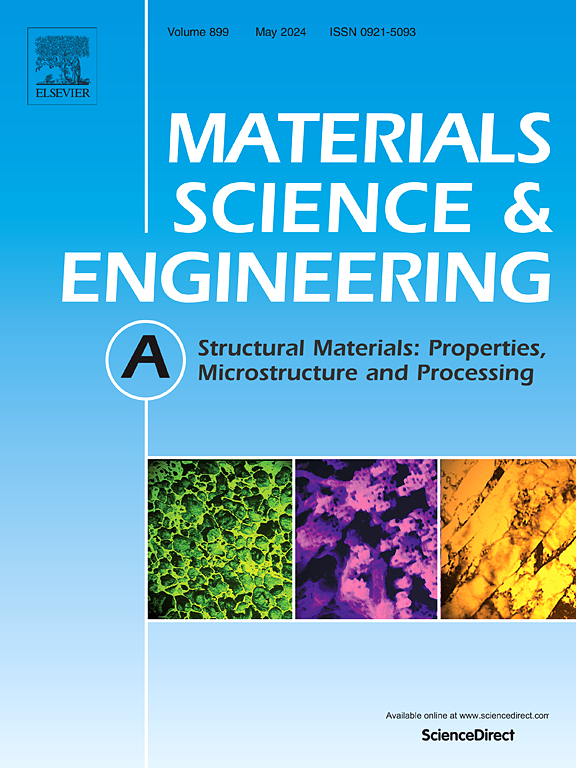Strain rate induced TRIP/TWIP effects and damage initiation in a novel Fe-Mn-Al-Nb medium manganese steel: Experiments and modeling
IF 6.1
2区 材料科学
Q1 MATERIALS SCIENCE, MULTIDISCIPLINARY
引用次数: 0
Abstract
To evaluate the strength and plasticity of Fe-Mn-Al-Nb medium manganese steel (MMnS) under extreme impact conditions, tensile tests were carried out using a universal testing machine and a split Hopkinson tensile bar, with strain rates ranging from 0.001 s−1 to 3000 s−1. The initial crystal orientation data provided by electron backscatter diffraction (EBSD) were used to establish a crystal plasticity phase-field (CP-PFM) model using DAMASK software, and the plasticity behavior and damage evolution of this model were studied. The study systematically examines the plastic deformation mechanisms of MMnS at strain rates of 0.001 s−1 to 3000 s−1, as well as damage initiation at the dynamic strain rate. The results show that strain hardening at 0.001 s−1 is mainly determined by the transformation induced plasticity (TRIP) effect and dislocation activity. At the strain rate of 3000 s−1, initial hardening results primarily from the combined actions of dislocations and the TRIP effect, while subsequent hardening is dominated by the TRIP and twinning induced plasticity (TWIP) effects. Dislocation accumulation leads to the formation of low-angle grain boundaries and promotes strain localization. In addition, austenite is capable of activating a greater number of slip systems compared to ferrite, enabling it to accommodate external forces via multiple slip pathways. This characteristic results in enhanced plasticity and deformation capacity for austenite. It is noted that damage nucleates initially at the interfaces between ferrite and austenite grains and then diffuses into the grains.
新型Fe-Mn-Al-Nb中锰钢应变速率诱导的TRIP/TWIP效应和损伤萌生:实验与建模
为了评估Fe-Mn-Al-Nb中锰钢(MMnS)在极端冲击条件下的强度和塑性,采用万能试验机和分离式霍普金森拉伸杆进行了拉伸试验,应变速率范围为0.001 s−1 ~ 3000 s−1。利用电子背散射衍射(EBSD)提供的初始晶体取向数据,利用DAMASK软件建立了晶体塑性相场(CP-PFM)模型,并对该模型的塑性行为和损伤演化进行了研究。该研究系统地研究了MMnS在应变速率为0.001 s−1至3000 s−1时的塑性变形机制,以及在动态应变速率下的损伤起裂。结果表明,在0.001 s−1时的应变硬化主要由相变诱发塑性(TRIP)效应和位错活动性决定。在3000 s−1应变速率下,初始硬化主要是位错和TRIP效应的共同作用,而后续硬化主要是TRIP和孪晶诱导塑性(TWIP)效应。位错积累导致低角度晶界的形成,促进应变局部化。此外,与铁素体相比,奥氏体能够激活更多的滑移系统,使其能够通过多种滑移途径适应外力。这一特性提高了奥氏体的塑性和变形能力。结果表明,损伤首先在铁素体和奥氏体晶粒之间的界面处形核,然后扩散到晶粒中。
本文章由计算机程序翻译,如有差异,请以英文原文为准。
求助全文
约1分钟内获得全文
求助全文
来源期刊

Materials Science and Engineering: A
工程技术-材料科学:综合
CiteScore
11.50
自引率
15.60%
发文量
1811
审稿时长
31 days
期刊介绍:
Materials Science and Engineering A provides an international medium for the publication of theoretical and experimental studies related to the load-bearing capacity of materials as influenced by their basic properties, processing history, microstructure and operating environment. Appropriate submissions to Materials Science and Engineering A should include scientific and/or engineering factors which affect the microstructure - strength relationships of materials and report the changes to mechanical behavior.
 求助内容:
求助内容: 应助结果提醒方式:
应助结果提醒方式:


